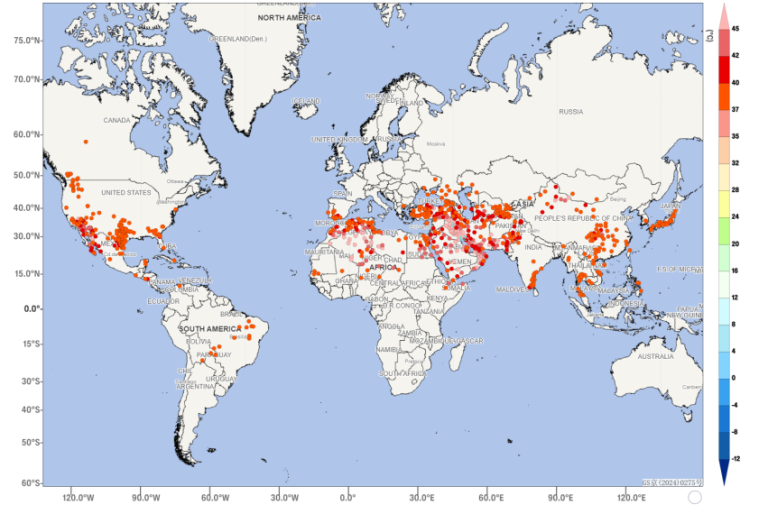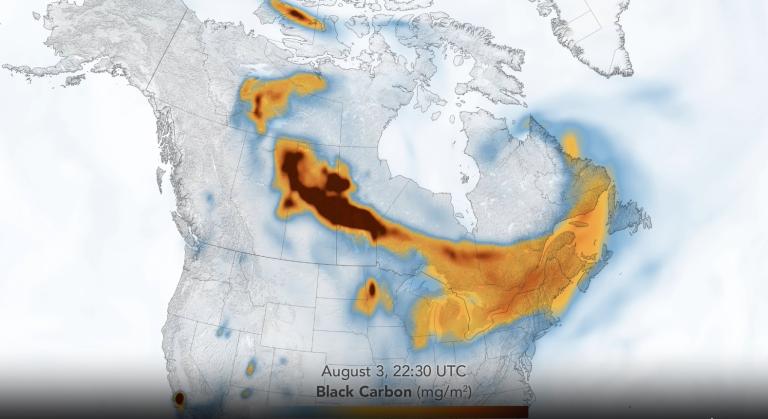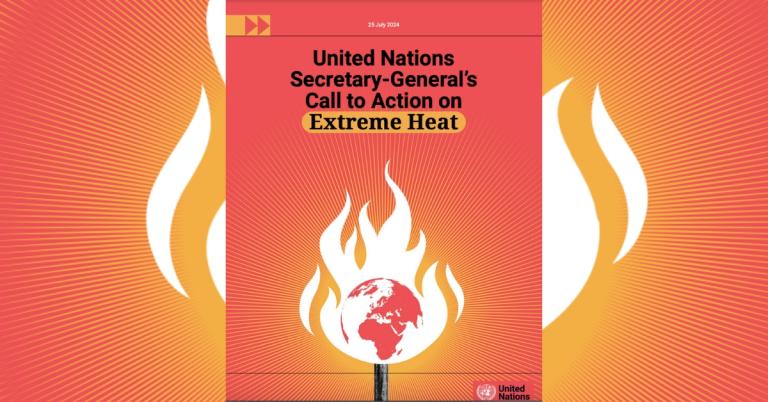Extreme heat - with dangerously high daytime and overnight temperatures is impacting millions of people around the world, underlining the importance of early warnings and heat-health action plans. Wildfires and poor air quality are compounding the problem.
WMO and its Members are therefore committed to bolster heat early warning systems in line with the Early Warnings for All initiative and are working with partners at international, national and community level to strengthen heat-health action plans.
WMO is one of ten specialized United Nations entities rallying behind the UN Secretary-General's Call to Action on Extreme Heat .
"Extreme heat is sometimes called the silent killer, but with today's science, data and technologies, silence is no longer an excuse. Every single death from extreme heat is preventable," said WMO Deputy Secretary-General Ko Barrett.
Modelled estimates show that between 2000 and 2019, approximately 489,000 heat-related deaths occurred each year, with 45 per cent of these in Asia and 36 per cent in Europe. Worldwide, the official diagnosis and reporting of heat-related illness, injuries and deaths are recognized to be under-reported.
In cities, the impact of heat on human health is more pronounced due to the urban heat island effect. Elderly people and those with chronic illness are at higher risk.
The need for action is evident on a daily basis.

Temperature records
July 2025 was the third-warmest July globally (after July 2023 and 2024), according to the EU's Copernicus Climate Change Service. The average sea surface temperature was also the third highest on record. Arctic sea ice extent ranked joint second-lowest for July in the 47-year satellite record, virtually tied with 2012 and 2021.
Within Europe, heatwave conditions particularly affected Sweden and Finland, which experienced an unusually long spell of temperatures above 30 °C. Southeast Europe also faced heatwaves and wildfire activity, with a national record temperature of 50.5 °C in Türkiye.
Outside Europe, temperatures were most above average across the Himalayas, China and Japan, according to the Copernicus Climate Change Service monthly bulletin.
The heat has continued into August.
An update from the World Meteorological Centre Beijing on 5 August said that in the past week, maximum temperatures exceeded 42 °C in parts of West Asia, southern Central Asia, most of North Africa, southern Pakistan, and the southwestern United States, with localized areas surpassing 45 °C.
Maximum temperatures in southwestern Islamic Republic of Iran and eastern Iraq locally exceeded 50 °C - causing disruptions to electricity and water supplies, education and labour.
The National Meteorological Service of Morocco issued a heat warning for temperature between 40 and 47°C for the week of 4 August.
'' Typically, during the summer, the combination of extreme heat at the near-surface and cold air aloft might lead to subsequent extreme rainfall and devastating flash-floods over high topography, affecting further people's lives, infrastructure and landslides,'' said Omar Baddour, chief of climate monitoring at WMO.

Japan reported a new national temperature record of 41.8 degrees Celsius (107.2 degrees Fahrenheit) on 5 August, beating the record of 41.2 °C set on 30 July. During the extended and extraordinary heatwave, many dozens of new station records - both maximum daytime and minimum overnight ones - were set. Japan's Meteorological Agency issued special heat stroke alerts, urging the public to take precautionary measures.
The Korea Meteorological Administration has also issued widespread extreme heat warnings and advisories. Station temperature records also tumbled in parts of China.
The World Meteorological Centre Beijing said that in the next week, the heatwaves are expected to continue across most of West Asia, southern Central Asia, most of North Africa, the Iberian Peninsula, Pakistan, the southwestern United States, and northern Mexico.
Maximum temperatures in most of these regions will range between 38 and 40 °C, with some areas exceeding 42 °C, it said. Specifically, localized temperatures could reach above 45 °C in Saudi Arabia, Iraq, Syria, western and southern Iran, the southwestern United States, and parts of North Africa.
Wildfires
The extreme heat has fuelled devastating wildfires, causing casualties and worsening air quality.
Fire fighters in Cyprus, Greece and Türkiye struggled against wildfires, which forced people to flee their homes, claimed a number of lives, and filled the skies with thick plumes of smoke.
Smoke from hundreds of wildland fires burning in Canada created hazy skies and poor air quality across multiple provinces and northern U.S. states in late July and early August 2025. Air pollution affected areas of the Northwest Territories, Alberta, Saskatchewan, Manitoba, and Ontario, as well as parts of the U.S. Upper Midwest and Northeast, according to NASA's Earth Observatory .
Canada is facing one of its worst fire seasons on record in terms of area burned. As of August 3, more than 6.6 million hectares (16.3 million acres) had burned, according to the Canadian Interagency Forest Fire Center . That exceeds the 25-year average of about 2.2 million hectares but trails the more than 12.3 million hectares burned by this date in 2023, a record-setting year.
For at least the second time this season, smoke from these blazes travelled across the Atlantic Ocean bound for Europe. Carried by a strong jet stream, it was expected to reach Western European skies between August 5 and 7. In mid-June 2025, another smoke plume from Canada degraded air quality and reddened skies in Central and Southern Europe.
A devastating wildfire raged in Arizona's Grand Canyon National Park, causing major disruption to tourism in one of the USA's best-known natural attractions.

WMO Response
WMO is one of ten specialized United Nations entities rallying behind the UN Secretary-General's Call to Action on Extreme Heat .
This seeks to enhance international cooperation to to minimize heat impacts through targeted economic and social policies and concrete actions, including public awareness campaigns. There are four critical areas:
- Caring for the vulnerable
- Protecting workers
- Boosting resilience of economies and societies using data and science
- Limiting global temperature rise to 1.5 °C above pre-industrial average
In response to the Call to Action, WMO and its Members are working to bolster heat early warning systems in line with the Early Warnings for All initiative . This aims to ensure at-risk populations receive timely alerts that include information on protective actions to undertake and sources of assistance.
According to estimates produced by the WHO and WMO that the global scale-up of heat health-warning systems for 57 countries alone has the potential to save an estimated 98,314 lives per year.
"Extreme heat is no longer a distant or seasonal concern-it's a daily reality for millions." said Joy Shumake-Guillemot , lead of the WHO-WMO Climate and Health Joint Programme and co-lead of the Global Heat-Health Information Network (GHINN) .
"Our Network is connecting science, policy, and action so that no community is left behind in the race to adapt to climate change that will continue to worsen extreme heat for years to come. This is not just a climate issue, it's a public health emergency," she said.
On the first anniversary of the Call to Action on 25 June, the Global Heat Health Information Network (GHHIN), together with the World Meteorological Organization and the UN Office for Disaster Risk Reduction, launched new resources through their joint initiative, Supporting Extreme Heat Risk Governance to strengthen coordination on heat risk reduction, helping countries and communities better prepare for rising temperatures.
The work of the Joint Climate and Health Office has been boosted by a partnership with the Rockefeller Foundation and Wellcome, which have jointly mobilized U.S. $11.5 million. There is a particular focus on extreme heat.
Supporting extreme heat risk governance
The new resources launched by GHINN, UNDRR and WMO include:
- Stocktake Report: Heat action across United Nations Entities and International Organizations
This report examines the landscape of extreme heat management among for the first time, identifying challenges, opportunities, and strategies for improving collaboration and governance to support the United Nations Secretary-General's Call to Action on Extreme Heat.
- An Assessment of Heat Action Plans: Global standards, good practices and partnerships
This synthesis report identifies best practices and persistent challenges to provide a structured framework for improving heat resilience based on evaluations of heat action plans from six countries: Australia, Canada, France, India, the United Kingdom, and the United States.
- Narrative Analysis: Case studies in heat resilience
This narrative analysis highlights how 12 countries are confronting the realities of extreme heat through diverse governance models, partnerships, and innovations. The case studies span multiple regions and development contexts-Argentina, Australia, Bangladesh, Canada, Ecuador, Egypt, France, India, Senegal, the Republic of Korea, the United Kingdom, and the United States, offering a cross-cutting view of what is working, where gaps remain, and how national strategies are evolving in the face of escalating climate threats.







